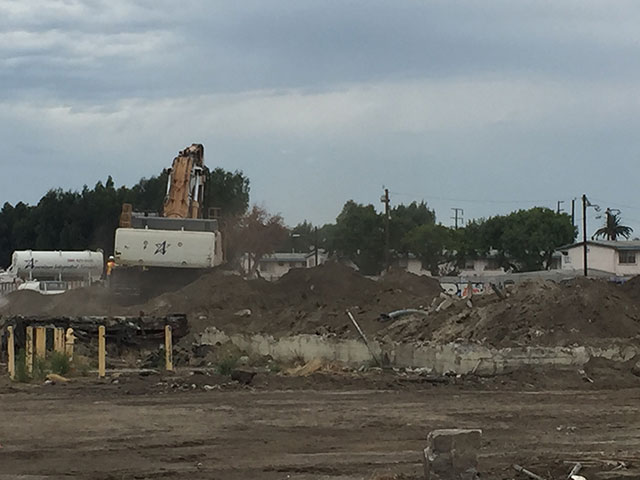
California’s regulatory agencies have repeatedly failed in their testing, enforcement and cleanup of various lead-contaminated sites in the state, an investigation by Truthout has revealed.
The investigation comprised three separate sites in and around Los Angeles: the Quemetco lead-acid battery recycling facility in the city of Industry, the Jordan Downs housing project in Watts (a toxic cleanup site), and a former police department firing range in Pasadena.
The pattern of lax regulatory enforcement at contaminated sites comes at a time when scientists recognize that lead – one of the World Health Organization’s 10 chemicals of major public health concern – has no safe levels, especially for fetuses and children.
Residents living in the shadow of the plant might have been at risk of lead contamination for decades.
High levels of lead exposure in young children, who are prone to ingesting contaminated dirt, can cause serious nervous system problems, as well as irreversible damage to IQ. The findings of one recent study suggest that the epigenetic effects of lead are passed down through generations. In California alone, lead exposure results in lost earnings of up to $11 billion over the lifetime of children born each year, according to a 2015 study by the Public Health Institute.
The state’s recent response to lead contamination around the Exide lead battery recycling plant has thrown a public spotlight on the issue. The Exide cleanup in the city of Vernon, which is already underway, is expected to encompass thousands of homes in what could prove to be the largest cleanup of its kind in the state. The cost per home is estimated to be in the region of $50,000.
“Unfortunately, there are more Exides just around the corner,” said Liza Tucker, a consumer advocate with Consumer Watchdog, a nonprofit, nonpartisan public interest group. “And Quemetco is the next Exide.”
Quemetco: The West Coast’s Only Lead-Acid Battery Recycler
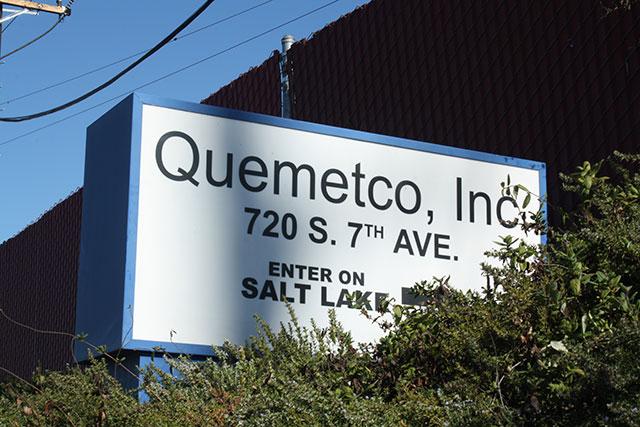 Outside of Quemetco lead-acid battery recycling facility in the City of Industry, Los Angeles. (Photo: Daniel Ross)
Outside of Quemetco lead-acid battery recycling facility in the City of Industry, Los Angeles. (Photo: Daniel Ross)
Now that Exide has been forced to close its doors, Quemetco is the sole lead-acid battery recycling facility on the West Coast. Operating since 1959, the plant can process up to 1.2 million pounds of materials a day.
In comparison to Exide, Quemetco has enjoyed a better environmental record due in no small part to the installation in 2008 of a wet electrostatic precipitator emissions control device that has massively reduced the amount of lead released into the air from the plant, according to Environmental Protection Agency (EPA) data.
But after conducting a file review of the Quemetco facility, Truthout has uncovered a series of findings that suggest that residents living in the shadow of the plant might have been at risk of lead contamination for decades, and that regulators have consistently failed to hold Quemetco to standards written into its operating permit.
“Regulatory agencies have continually delayed in taking meaningful actions to safeguard the health and well-being of the community.”
Quemetco and the state’s regulatory agencies have known about elevated levels of lead contamination in the surrounding vicinity of the battery recycling plant since 1991, when tests conducted up to 3,200 feet away from the facility found levels of lead as high as 10,300 parts per million (ppm). The current residential California human health screening level for lead is 80 ppm. However, no cleanup was conducted as a result.
The California Department of Toxic Substances Control (DTSC) excoriated Quemetco in a 2014 memorandum, writing how “more often than not, Quemetco is not in compliance with the provisions in their General Permit.” A serial violator, Quemetco has also been issued with multiple violations over the years, for such problems as illegally stored hazardous waste and crumbling buildings.
A spokesperson for RSR Corporation, Quemetco’s parent company, wrote that “any testing from 1992 did not determine the source of any lead detected and no order or request was issued by regulators to take any action beyond what was done. It should be noted that in 1992, vehicles were still using leaded gasoline and the use of leaded paint was of grave concern to regulators.”
Quemetco’s last general permit was issued in 2005. According to the company’s spokesperson, Quemetco and DTSC have “addressed” every condition in the 2005 permit over the past 10 years.
Read RSR Corporation’s response in full here.
This year, DTSC finally gave the go-ahead to an off-site investigation of the vicinity surrounding Quemetco. The investigation will be conducted in places in up to a one-mile radius away from the plant.
Quemetco is currently in the process of renewing its general permit and is eyeing Exide’s business, proposing to increase the amount of material it processes by up to 25 percent.
But a 2013 letter from DTSC states how “Quemetco operates much closer to residential areas than Exide.” And many fear that tests around the Quemetco plant will throw up similar findings to the plant in Vernon.
“We believe Quemetco will prove to be another Exide because, like with Exide, regulatory agencies have continually delayed in taking meaningful actions to safeguard the health and well-being of the community,” the Clean Air Coalition wrote in a joint statement. The coalition, a small group of residents, has for years been fighting for greater scrutiny of Quemetco’s operating practices.
“The real problem is that regulatory agencies treat polluters like Quemetco as legitimate businesses instead of the criminals we believe they really are,” they wrote.
Truthout invited the Department of Toxic Substances Control to comment but did not receive a response about Quemetco before our deadline. Questions about Quemetco were sent on November 9, along with questions concerning cleanups at Jordan Downs and the former firing range in Pasadena. Truthout received a response by the Department of Toxic Substances Control about the latter two cleanups.
Soil Tests Have Revealed Lead Contamination for Decades
The timeline of soil tests reveals that authorities knew for decades about the contamination around the battery recycling plant’s perimeter and the surrounding neighborhood.
Since 1991, multiple soil tests conducted around the perimeter of the facility and the surrounding neighborhood have shown levels of lead well above the 80 ppm residential lead threshold currently considered safe:
– A US EPA letter dated April 1, 1992, states how “the soil lead concentrations … are as high as 770ppm in the surrounding residential neighborhood.” No cleanups were ordered as a result of these findings.
– A joint report by DTSC and UCLA in the September 1995 issue of Environmental Science and Technology found that the connection between toxic elements found in soil samples collected around two secondary lead smelters in California “is the transport of these elements through the air from the plant to the soil.” The report doesn’t name Exide and Quemetco specifically, but it is implicitly understood that these two facilities are the plants in question.
– In 2004, soil tests conducted at a number of sites around the perimeter of the plant revealed lead levels as high as 5,300 ppm.
– Subsequent tests in 2005 found levels of lead as high as 8,774 ppm. As a result of these findings, Quemetco laid asphalt over some of the contaminated soil so as to “limit possible public exposure.”
– Further tests taken in 2012 confirmed how some areas remediated after 2005 had been recontaminated during the intervening years.
The findings of a 1992 and 1993 Department of Public Health study also suggest that more comprehensive testing should have been done sooner. The blood lead levels of children living near Quemetco were within a range now considered much higher than most children’s, and high enough to require case management.
A paper trail of documents illustrates how Quemetco has exerted pressure on regulators over the years, and has repeatedly attempted to narrow the breadth of any off-site tests.
A letter written by Quemetco’s attorney to DTSC in July 2004, for example, states how “there is no evidence that anyone is in danger, imminent or otherwise, due to lead contaminated soils near the Facility,” and warns that the department’s plan to hold a community meeting about the plant “may well prejudice the community against Quemetco before the facts are in.”
Pushing to curb the scope of the off-site cleanup, Quemetco wrote in a November 2015 letter to DTSC that it is “unclear how DTSC would be able to make such a showing to support this scope of testing which in many instances would have little or no relevance to any emissions originating from the Quemetco facility.”
Multiple Permit Conditions Have Remained Unmet for Ten Years
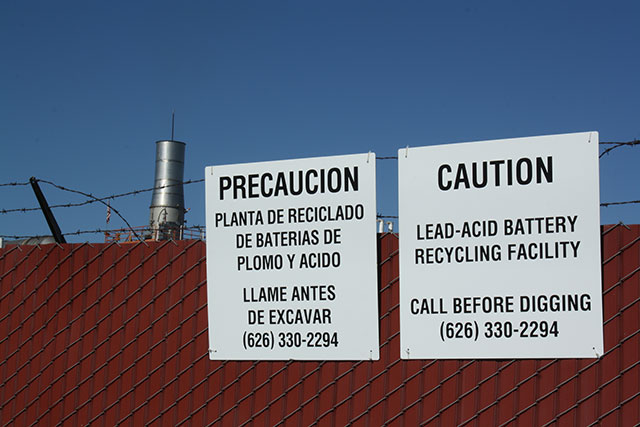 Outside of Quemetco lead-acid battery recycling facility in the City of Industry, Los Angeles. (Photo: Dan Ross)
Outside of Quemetco lead-acid battery recycling facility in the City of Industry, Los Angeles. (Photo: Dan Ross)
Quemetco has failed to comply with a variety of conditions included in their 2005 general permit in the 10 years since it was written. According to a 2013 draft report, DTSC has yet to approve response plans to monitor soil pore gas, soil pore liquid and surface water discharge.
“The Department of Toxic Substances Control has fallen down badly on its job of protecting the public from toxic harm.”
In a memorandum dated November 11, 2014, representatives from DTSC wrote that based on their review, “Quemetco appears to have been consistently discharging elevated levels of lead” into the San Jose Creek, which runs parallel to the plant. The San Jose Creek is listed by the EPA as “impaired and threatened.”
Even after Quemetco leaders assured authorities that they had corrected the problem, “the lead and zinc concentrations have since increased, not decreased … which would seem to contradict their assurances,” the letter states.
The Los Angeles Regional Water Quality Control Board said they issued Quemetco letters in 2010 and 2015 for “exceeding the benchmark values for lead, zinc, pH and specific conductance.”
Quemetco subsequently improved its best management practices, the control board wrote, “including increasing the frequency of sweeping paved surfaces at the facility, cleaning roofs and gutters, and installing new fences.”
Read the Regional Water Quality Control Board’s response in full here.
Quemetco has also failed to put together an adequate air monitoring response plan as directed in their 2005 permit. Since the permit was issued, Quemetco has been found guilty of multiple air quality violations, while numerous reports have highlighted the sheer scale of the pollutants emitted from their plant. For example:
– In 2006, Quemetco was found to have the highest cancer burden of any business within the South Coast Air Quality Management District’s jurisdiction (cancer risk comprises emissions of arsenic, 1,3-butadiene, cadmium and hexavalent chromium).
– In 2011, an EPA Toxic Release Inventory analysis found that Quemetco placed sixth among the state’s top 10 worst emitters of toxic materials.
– In 2012, the South Coast Air Quality Management District issued Quemetco a violation for failing to reconcile third- and fourth-quarter emissions of nitrogen oxides, a smog-forming emission.
– In October/November of 2013, SCAQMD source tests showed elevated emissions of the carcinogens arsenic, benzene and 1,3-butadiene.
Unplanned Shutdowns of the Emissions Control System
On its website, the RSR Corporation – with plants in New York and Indianapolis – boasts that its wet electrostatic precipitator emissions control device has proven effective at cutting emissions of lead and other hazardous air pollutants by more than 95 percent.
But the device at Quemetco has suffered five “unplanned shutdowns” over the past three and a half months alone, leading many to question its ability to manage increased “throughput” of materials, as has been proposed.
Since July 27, the precipitator has shut down five times. The longest of those times was for three hours and 10 minutes, though the duration of one “unplanned shutdown” has yet to be determined.
According to the RSR Corporation spokesperson, recent shutdowns of the wet electrostatic precipitator have been caused by either an “external power disruption” or from “internal systems which monitor the [precipitator] to assure that it is operating as designed.”
During an unplanned shut down, the facility stops processing batteries until the wet electrostatic precipitator is operational, the spokesperson wrote.
The South Coast Air Quality Management District did not respond to multiple questions posed by Truthout about the Wet Electrostatic Precipitator. These questions were sent on November 10.
Truthout also reached out to Los Angeles County Supervisor Hilda Solis for comment. Solis has been outspoken about Exide but declined to comment on Truthout’s findings until more information is brought to light. Solis’ father used to work at Quemetco.
$17.3 Million Added to Clean Up the Jordan Downs Housing Project
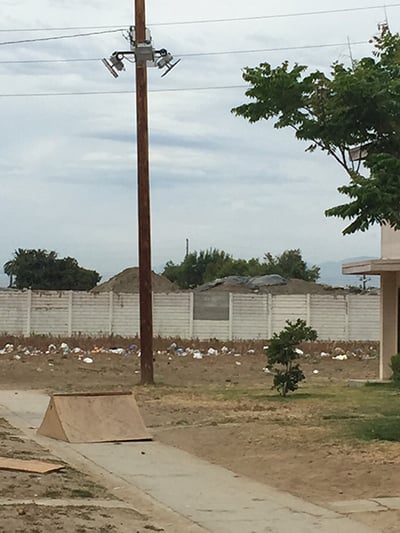 As much as 33,600 cubic yards of contaminated soil is being removed from a cleanup site at Jordan Downs in Watts, Los Angeles. Community advocates say the cleanup doesn’t meet health and safety standards. (Photo: Legal Aid Foundation)Earlier this year, Truthout conducted an investigation into various toxic sites in and around the Jordan Downs housing project, in Watts. Part of Truthout’s investigation focused on a cleanup at an old industrial site where roughly 33,600 cubic yards of contaminated soil is in the process of being excavated and removed. Among a cocktail of contaminants found, lead was detected at levels as high as 22,000 ppm.
As much as 33,600 cubic yards of contaminated soil is being removed from a cleanup site at Jordan Downs in Watts, Los Angeles. Community advocates say the cleanup doesn’t meet health and safety standards. (Photo: Legal Aid Foundation)Earlier this year, Truthout conducted an investigation into various toxic sites in and around the Jordan Downs housing project, in Watts. Part of Truthout’s investigation focused on a cleanup at an old industrial site where roughly 33,600 cubic yards of contaminated soil is in the process of being excavated and removed. Among a cocktail of contaminants found, lead was detected at levels as high as 22,000 ppm.
The cleanup site immediately abuts 700 homes in Jordan Downs, as well as Jordan High School (the scene of a separate lead cleanup). Jordan Downs is in one of the state’s most impoverished regions; the unemployment rate hovers around 24 percent, higher than 98 percent of the census tracts in California. Over half of the 2,700 residents at Jordan Downs are children under the age of 18.
As part of its response to questions posed by Truthout in April, DTSC promised that a number of precautionary measures would be taken to ensure that the cleanup wouldn’t pose any health risks to residents.
Those precautions included a “dust control plan” to ensure that soil from the site wouldn’t blow onto and recontaminate residential areas, while tires would be cleaned and trucks inspected to limit the tracking of contaminated soils out of the site.
Community advocates that have monitored the cleanup at Jordan Downs insist that DTSC has repeatedly failed to enforce these measures, and have observed and caught on camera dust from uncovered piles of soil on the cleanup site blowing onto residential areas. Some residents complained of dust blowing into their homes.
Piles of dirt were found beyond the perimeter wall of the site adjacent to homes, say residents and advocates. Tire tracks of dirt were seen threading out of the site, while workers (some of them local residents) were seen repeatedly without the correct safety clothing.
“There was one gentleman in hospice care in his home when this was going on during the heat wave, and his wife wasn’t able to open the windows to give him relief while he was dying because of the dust flying about,” according to Alexander Harnden, staff attorney at the Legal Aid Foundation of Los Angeles, who sent a letter during the summer to DTSC and the housing authority listing his findings and concerns.
The letter can be read here, and a response by the housing authority can be read here.
In response to community concerns, DTSC implemented a number of measures, including additional fence coverage, an increase of monitoring stations, and increased dust control measures and street sweeping, a spokesperson for the department told Truthout.
“Our oversight of the mitigation measures has successfully reduced risks to the surrounding community during this important cleanup,” said the spokesperson, adding that soil sampling was conducted off-site and near the residential areas to investigate migration of contaminants.
“Results showed that levels of lead and other chemicals of concern are within background levels of the Los Angeles area. There is no evidence that the contaminated dust has made it off-site. The monitoring reports have shown that the air leaving the site has no contaminants,” the spokesperson wrote.
The Department of Toxic Substances Control’s full response can be read here.
A further $17.3 million was recently allocated toward the cleanup of the site at Jordan Downs, pushing the cost of the cleanup to $31.3 million.
Monika Shankar, health and environment associate at Physicians for Social Responsibility, is concerned that residents will continue to be put at risk of recontamination and further money will be wasted if the cleanup fails to be adequately overseen in the future.
“They’re pumping a lot of money into this,” Shankar said. “We’ve been very concerned with this whole issue for a long time. What we’ve noticed are the ongoing violations that can cause very serious health conditions. Lead and arsenic are incredibly grave toxic contaminants … The folks who are most vulnerable to toxic contamination are mothers and children.”
Pasadena: Lead May Pollute River Along Popular Hiking Trail
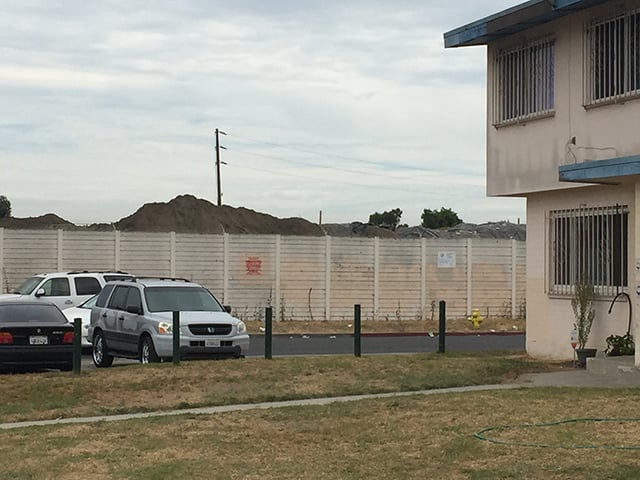 As much as 33,600 cubic yards of contaminated soil is being removed from a cleanup site at Jordan Downs in Watts, Los Angeles. Community advocates say the cleanup doesn’t meet health and safety standards. (Photo: Legal Aid Foundation)
As much as 33,600 cubic yards of contaminated soil is being removed from a cleanup site at Jordan Downs in Watts, Los Angeles. Community advocates say the cleanup doesn’t meet health and safety standards. (Photo: Legal Aid Foundation)
The third location that Truthout investigated was the site of a former firing range previously used by the Pasadena Police Department. The five-acre site sits toward the north of Pasadena, near the foothills of the San Gabriel Mountains. A storm drain connects the site with the nearby Eaton Canyon Wash, which makes up part of a popular local nature trail.
Tests conducted at the site in 2014 found lead concentrations that exceeded the residential California human health screening level of 80 ppm “in 33 of 38 samples collected.” Lead concentrations in these areas were found to be as high as 13,100 ppm.
Truthout requested that all documents relating to the cleanup be made available. A spokesperson for DTSC said a work plan to clean up the site is currently with the City of Pasadena for review, and is unavailable to the public. It is hoped that the work plan will be finalized before the end of 2015. The cleanup is estimated to cost in the region of $2.5 million to $3 million.
Truthout, however, has obtained a copy of a report that was not made available. The report can be read here, and shows “heavy concentrations of bullet casings” strewn throughout the range, some of which are found in the mouth of the storm drain. No screen or barrier prevents further bullet casings entering the drain.
The report recommends further investigation of the storm drain, including where it discharges, though none of the documents available to the public mention the storm drain, nor has any testing of Eaton Canyon Wash been conducted.
Experts that have studied the documents have expressed concern that not enough has been done to ensure that Eaton Canyon Wash has not been contaminated by the lead found in the range.
“DTSC has no record of the Eaton Canyon Wash being tested for lead,” a Department of Toxic Substances Control spokesperson wrote in response to questions. “DTSC was made aware of this contamination last year. Three weeks after being made aware of this contamination, DTSC requested that the City clean this contamination, but the City says that they are out of funds. In October, DTSC sent a letter to the City asking that they enter into an agreement with us for the cleanup. We are waiting for the City to respond.”
These three cases are just the tip of the iceberg, Consumer Watchdog’s Liza Tucker said.
“Laced throughout them is the evidence that our top toxics regulator, the Department of Toxic Substances Control, has fallen down badly on its job of protecting the public from toxic harm,” she said.
Tucker said a new system of regulation is necessary whereby health, soil, air and water regulators work together to prevent pollution in the first place, recognize that pollution does not stop at a site’s fence line, force those responsible for pollution to clean up and deny permits to serial industrial polluters.
Matching Opportunity Extended: Please support Truthout today!
Our end-of-year fundraiser is over, but our donation matching opportunity has been extended! Today, all donations to Truthout will be matched dollar for dollar. Your one-time gift today will be matched immediately. As well, your monthly donation will be matched for the whole first year, doubling your impact.
This matching gift comes at a critical time. Trump has made it no secret that he is planning a demolition-style attack on both specific communities and democracy as a whole, beginning on his first day in office.
Help us prepare for Trump’s Day One, and have your donation matched today!